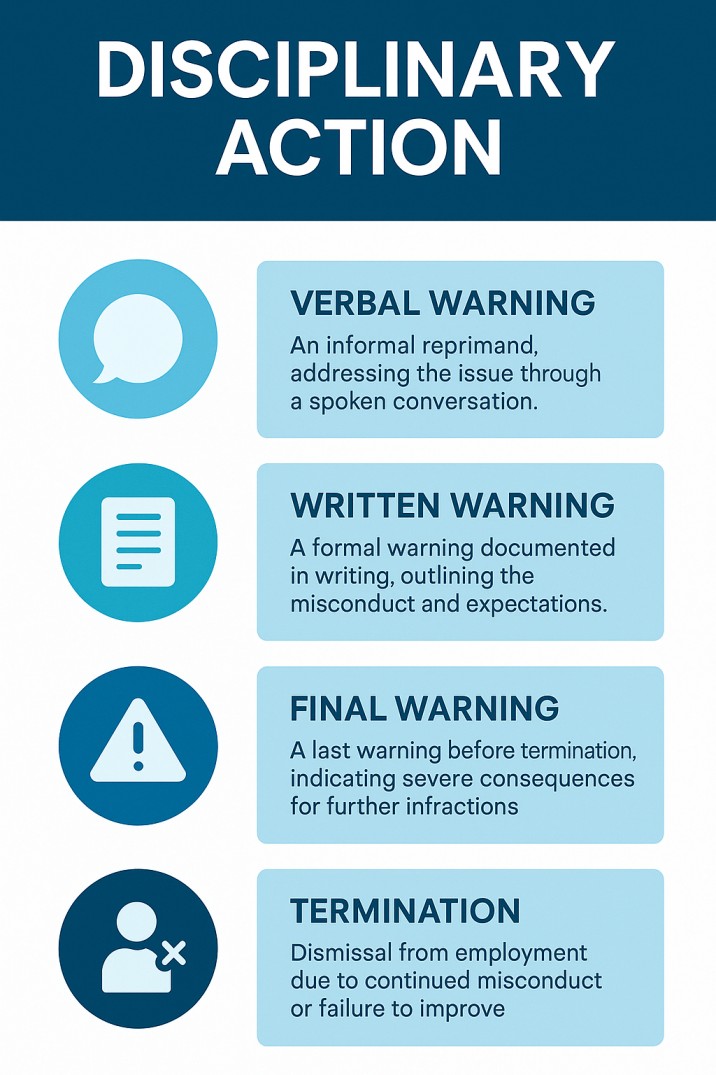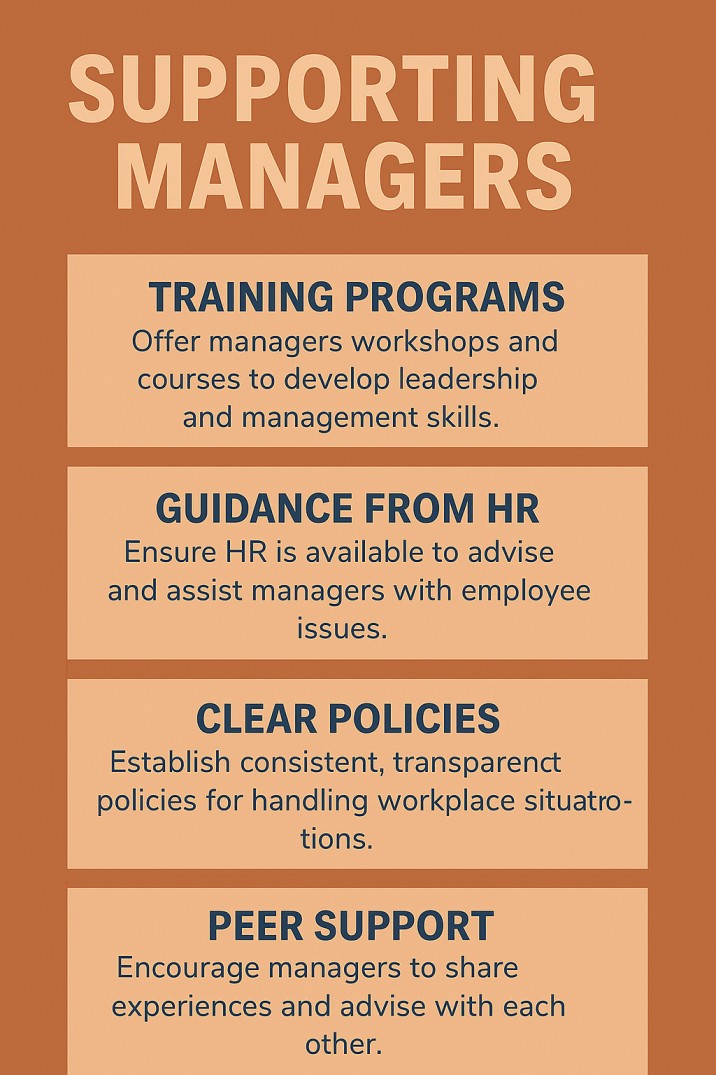Disciplinary action is one of the most delicate yet essential processes within any workplace. While no employer sets out to penalize their employees, addressing misconduct or underperformance is crucial for maintaining fairness, productivity, and a healthy organizational culture. The stages of disciplinary action are designed not to punish, but to provide structure and clarity—offering a path to improvement before more serious consequences are imposed.
At its core, disciplinary action is about accountability. It’s a framework that helps both employers and employees understand expectations, boundaries, and consequences. Whether it’s a verbal warning for lateness or a final notice for repeated policy violations, each step serves a purpose in reinforcing company standards.
Why Disciplinary Action Exists

A workplace without boundaries quickly descends into chaos. Disciplinary action serves as a safeguard that protects not only company goals but also individual morale. When rules are enforced inconsistently or not at all, high-performing employees may feel frustrated and disengaged. Meanwhile, others may push limits simply because they can. This is where disciplinary action becomes a balancing tool—providing a fair way to correct behaviors while offering the opportunity for personal growth.
Importantly, disciplinary action is not a one-size-fits-all approach. The nature of the misconduct, the individual’s history, and the company’s values all factor into how situations are handled. The key is consistency and documentation, ensuring that similar offenses are treated similarly across the board.
The First Step: A Verbal Warning
The beginning of any disciplinary action process typically starts with a verbal warning. Often informal, this step is designed to bring attention to a behavior that’s problematic but not yet severe. It’s a conversation, not a confrontation. The goal is clarity—not shame.
According to statistics a verbal warning is a disciplinary measure where an employer speaks to an employee about an issue involving their behaviour, conduct, or job performance.
A manager might approach an employee after noticing a pattern, such as repeated tardiness or missed deadlines. The issue is discussed openly, expectations are restated, and the employee is often given a chance to explain or contextualize the behavior. Although it’s not documented officially, the verbal warning is often noted internally, serving as a reference if the issue persists.
When Behavior Persists: Written Warnings
After a verbal warning has been issued and the problematic behavior continues, the next step in the disciplinary process is a formal written warning. This is when disciplinary action moves from informal discussion to documented procedure, often using an employee disciplinary action form to ensure every detail is recorded accurately and professionally.
Formalizing the Concern
A written warning marks a turning point in how the issue is handled. While a verbal warning is meant to give an employee the benefit of the doubt, a written warning is used when improvement isn’t seen—or when the behavior is more serious. The employee disciplinary action form becomes the official record, capturing essential elements such as:
- A clear description of the misconduct or performance issue
- The date(s) the behavior occurred
- Specific company policies that were violated
- Expected changes and a timeline for improvement
This form ensures transparency and provides a consistent framework for all future disciplinary decisions.
Why Documentation Matters
The employee disciplinary action form is more than just paperwork—it’s a tool that protects both the employer and the employee. For employers, it serves as a documented history of due diligence and fair treatment, which is especially important if further action is required down the line. For employees, the form clarifies the seriousness of the situation and what they need to do to make things right.
Without such documentation, misunderstandings can arise, and disciplinary measures may be perceived as unfair or arbitrary. That’s why HR departments rely heavily on standardized forms to maintain consistency and legality in their processes.
A Turning Point for Accountability
In many cases, receiving a written warning—and signing an employee disciplinary action form—can trigger a change in mindset for the employee. It acts as a wake-up call, a signal that continued issues will have real consequences. For employees who are willing to improve, this stage provides clarity and structure. They now know exactly where they stand and what actions are required to avoid further disciplinary steps.
Managers and supervisors should use this moment not only to document the behavior but also to communicate support. Reinforcing the idea that the written warning is a chance for growth—not punishment—can help re-engage employees and set them on the right track.
The Role of the Disciplinary Form in Communication
An employee disciplinary action form should be presented during a private meeting, ideally with both the direct supervisor and an HR representative present. This creates a professional setting where expectations can be reinforced clearly, and the employee has a chance to respond. It’s critical that the discussion be constructive rather than confrontational.
Once the form is reviewed, both parties typically sign it, confirming that the issue was discussed and that the employee understands the next steps. While signature does not always indicate agreement with the content, it confirms acknowledgment, which is legally important.
Consistency Across the Organization
Using a standardized employee disciplinary action form ensures consistency in how discipline is applied across teams and departments. It reduces bias, ensures compliance with labor regulations, and helps maintain organizational integrity. Whether the issue is absenteeism, insubordination, or performance-related, the use of a consistent form keeps the process objective and fair.
For companies aiming to build a culture of accountability and transparency, relying on formal documentation like an employee disciplinary action form is essential. It aligns the company’s values with its policies, reinforcing that everyone is held to the same standards.
Escalation: Final Written Warnings
A final written warning signals that the employee is on the brink of termination. It’s the most serious stage of disciplinary action short of dismissal. This warning makes it clear that any additional issues—regardless of severity—could result in job loss.
At this point, disciplinary action becomes highly structured. Meetings are documented, HR is almost always involved, and timelines for improvement may be imposed. The final warning isn’t just a threat; it’s an opportunity for redemption. Employers may provide additional resources like mentorship, training, or a performance improvement plan to help the employee succeed.
Even with the finality of this stage, the emphasis remains on fairness. Employers don’t want to terminate if they can help it—turnover is costly, and replacing staff disrupts operations. Still, disciplinary action at this level requires both parties to be deeply engaged in resolving the issue quickly.
Termination: The Last Resort
When all prior stages of disciplinary action fail to produce a change, termination becomes necessary. This is the most serious outcome and should only occur when an employee has repeatedly failed to meet expectations despite ample warning and opportunity.
Termination isn’t always the result of repeated behavior. Some actions—such as harassment, violence, or theft—warrant immediate dismissal. But in the vast majority of cases, disciplinary action is designed to give every chance for correction before arriving at this point.
Handled poorly, terminations can damage morale and invite legal risk. Handled well, they can reinforce a company’s values and send a clear message about behavioral standards. It’s a difficult but sometimes necessary decision, and it underscores the importance of having a clearly defined disciplinary action policy in place.
The Role of Documentation

Throughout every stage of disciplinary action, documentation is key. This ensures that employers have a consistent record of what was communicated, when it was discussed, and how the employee responded. In the event of legal challenges or internal reviews, these records demonstrate that the company acted in a fair, non-discriminatory manner.
Documentation also benefits the employee. It helps them track their own progress, see where they’ve fallen short, and recognize opportunities for growth. Transparency builds trust—even when the content of the documents is hard to accept.
Creating a Culture of Accountability
The most effective disciplinary action systems aren’t reactive—they’re proactive. They’re built into the company culture from the beginning, woven into onboarding sessions, employee handbooks, and performance reviews. When employees know what’s expected and how disciplinary action is handled, they’re more likely to self-correct before management ever has to step in.
Clear communication helps too. Employees need to understand not only what behaviors are discouraged, but also what actions are rewarded. Disciplinary action is only one half of the behavioral equation; the other half is recognition, appreciation, and support.
Supporting Managers Through the Process

Many managers find disciplinary action emotionally draining. After all, it involves conflict, tough conversations, and the risk of being misunderstood. That’s why training and HR support are so crucial. Managers must know how to handle these situations calmly and consistently.
An untrained manager may overreact or avoid necessary disciplinary action altogether. Both can have damaging consequences. By giving managers tools and frameworks, organizations empower them to uphold standards while treating employees with dignity and respect.
A Second Chance Mentality
One of the most overlooked aspects of disciplinary action is its capacity for redemption. Not every warning leads to termination. In fact, many employees bounce back stronger than before, especially when they feel supported and heard.
Leaders who understand the purpose of disciplinary action often use it as a moment of mentorship. They help employees see the gap between current behavior and expected behavior—and guide them in bridging it.
This approach reinforces a culture where mistakes are learning opportunities. While not every situation has a happy ending, many do. Disciplinary action becomes not just a consequence, but a catalyst for improvement.
Legal and Ethical Considerations
Finally, it’s critical to view disciplinary action through both a legal and ethical lens. Unfair treatment, vague policies, or inconsistent enforcement can open the door to lawsuits and employee mistrust. Employers must ensure that every step—from the first verbal warning to potential termination—is grounded in fairness, transparency, and documentation.
Having a structured disciplinary action policy helps eliminate bias and reduce risk. When employees know what to expect, they’re more likely to accept the outcome—even if they disagree with it.
Final Thoughts
Disciplinary action is never easy, but it’s essential. It provides structure in moments of uncertainty and offers a roadmap for both accountability and growth. From the first warning to a potential termination, each stage serves a purpose. When handled correctly, disciplinary action isn’t just about addressing problems—it’s about protecting the integrity of the team and giving every employee a fair chance to rise.
Andrea Balint is a writer and researcher focused on human behavior, workplace psychology, and personal growth. Through her work at CareersMomentum, she explores how mindset, leadership, and emotional intelligence shape modern careers. With a background in communication and HR development, she transforms complex ideas into practical insights that help readers build clarity, confidence, and professional purpose.
